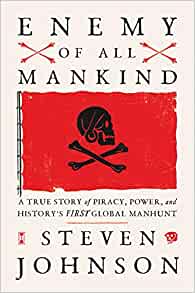Pirate Booty Call

In the pantheon of pirates, Henry Every isn’t mentioned in the same breath as Sir Francis Drake or Blackbeard or Captain Morgan, if he is mentioned at all. Yet in 1695, thanks to hard work, a fast boat and a lucky shot, Every scored what some consider to be the biggest heist — not only in the annals of buccaneering, but in the history of crime.
More remarkable, despite a worldwide manhunt, Every and most of his crew got away with it — along with loot estimated to be as much as $60 million in today’s currency. This now forgotten Englishman from Devon was the Osama bin Laden of his day, in the crosshairs of the world’s seafaring nations and fellow pirates alike. He would have fetched the equivalent of $50,000, dead or alive.
In his thirteenth book, "Enemy of All Mankind: A True Story of Piracy, Power, and History's First Global Manhunt" (Riverhead, 304 pp., ★★★½ out of four), Steven Johnson salvages his subject from the dustbin of history and puts his brief swashbuckling career in the context of the era’s historical currents. It is the perfect book to cozy up to during a pandemic.
In addition to providing captivating “yo ho ho and a bottle of rum” action, the author examines the geopolitical and cultural implications of Every’s spasm of violence. His subject changed the very nature and geography of piracy in the eighteenth century.
Among the factors that suppressed Every’s renown is that he took the money and retired, to be heard of thereafter only in back-alley whispers and rum-fueled rumors. What’s more, precious little was known of his life before he made a career change from first mate in the Royal Navy to Hostis humani generis, or “Enemy of all mankind.” (That same legal term was used to justify the incarceration of "enemy combatants" at Guantanamo Bay.)
But first things first: his act of piracy was singularly astonishing. The target was the Ganj-i-Sawai, owned by Grand Mughal Aurangzeb of India. Not only was it brimming with unimaginable treasure, the enormous ship was bristling with 80 canons and 400 muskets and carried nearly a thousand men. Its attacker, the Fancy, had but 113 men and less than 50 canons, and was dwarfed by its victim. David and Goliath come to mind.
Every plied his trade during a confusing time in world affairs. Drake and other “privateers” had done their plundering in service to their sovereign, while the East India Company, an English corporation, deployed its own armed forces and acted like a nation state on the Indian Ocean and beyond. The demarcation lines between nations, pirates and companies were blurry, Johnson points out.
Within 60 years of Every’s big score, the East India Company—despite being suspected by its trading partners in piracy—would control large parts of the Indian subcontinent and beyond. Eventually it would deploy more soldiers across its corporate empire than Great Britain could muster.
Johnson skillfully ushers the reader into the peculiar world of Every and his crew, who began their voyage on a legitimate commercial mission that went bad — ergo their mutiny. The author ably documents the radical egalitarianism of pirate culture: one buccaneer one vote; all sharing equally in the booty (except the captain, who got two shares); there was even disability insurance.
Indeed, the term “strike” derives from seamen like Every, who would strike their sails to show displeasure with management. When that failed, mutiny sometimes followed.
Every’s working class piratical idyll would be more appealing if it weren’t for the torturing, raping, and slaving that were also part of its modus operandi. Previous to this book it did garner a bit of recognition: in the 2016 video game "Uncharted 4: A Thief's End."